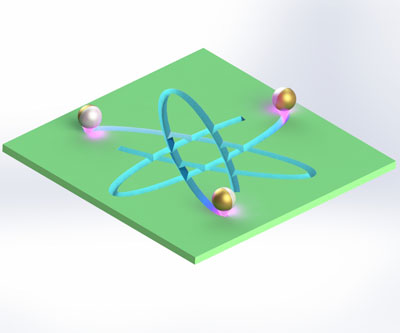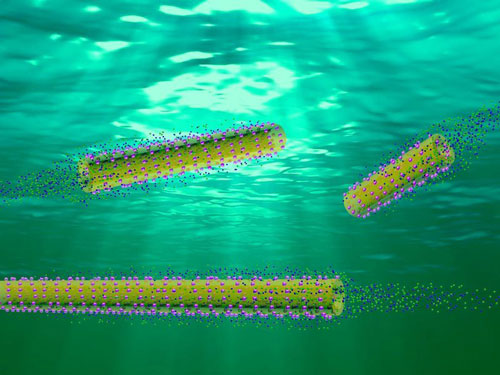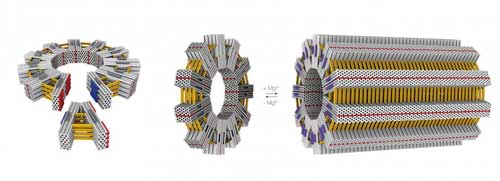What are nanobots?
Content
Currently, there is no existing technology for nanoscale robots as depicted in science fiction works such as Michael Crichton's Prey. However, in medical nanotechnology, the term nanobot or nanorobot is used to describe programmable molecules that can perform specific tasks. These nanobots are a reality and are being actively researched and developed.
The field of nanorobotics involves the design, creation, and control of these nanoscale programmable molecules. Researchers are actively exploring the potential of programmable self-assembly properties of nucleic acids to create nanoshapes and nanomachines. A key area of focus is DNA assembly, including a technique known as DNA origami.
An ever-increasing number of research groups are exploiting programmable self-assembly properties of nucleic acids in creating rationally designed nanoshapes and nanomachines for many different uses. That's why one of the most actively researched areas of nanorobotics today involves DNA assembly, particularly a technique called DNA origami (see below for more details).
The field of nanorobotics
Let's start with some basics: Robotics can be defined as the theory and application of robots, a completely self-contained electronic, electric, or mechanical device, to such activities as manufacturing.
Scale that robot down to a few billionth of a meter and you are talking nanotechnology robotics; nanorobotics in short. The field of nanorobotics brings together several disciplines, including nanofabrication processes used for producing nanomotors, nanoactuators, nanosensors, and physical modeling at nanoscales.
Nanorobotic manipulation technologies, including the assembly of nanometer-sized parts, the manipulation of biological cells or molecules, and the types of robots used to perform these tasks also form a component of nanorobotics.
For instance, researchers have translated the autonomous movement trajectories of nanomotors into controlled surface features that brings a twist to conventional static optical fabrication systems, which establishes an early stage approach for a nanorobotics platform for nanomanufacturing.

Nanotechnology robots are quintessential NEMS (nanoelectromechanical systems) and raise all the important issues that must be addressed in NEMS design: sensing, actuation, control, communications, power, and interfacing across spatial scales and between organic and inorganic materials. Due to their size, comparable to biological cells, nanorobots have a vast array of potential applications in fields such as environmental monitoring or medicine.
However, researchers today mostly use the term nanorobot to describe molecules with a unique property that enables them to be programmed to carry out a specific task.
Which brings us to:
Nanobots in medicine
There are plenty of scaremongering articles out there, often as part of intricately spun and simply crazy conspiracy theories, that refer to nanomachines in humans, injectable nanobots, brain nanobots, nanotechnology spying, ask questions like can nanobots control you? or how to detect nanobots, and then go on to give 'helpful' advice on how to remove nanomites from the body, how to deactivate nanobots, how to destroy nanobots, or if the article takes a positive spin, how nanobots will lead to immortality.
Now, lets put both feet on the ground, take off the tin hat, and check in with reality. And, no, don't google how much nanobots cost and where to buy them. You can't. And please don't ask us either.
When we talk about nanobots today the reference mostly is to self-propelled nanomotors and other biodegradable nanodevices made of bio-nano components, which carry cargo to the target sites, i.e. deliver drugs to diseased cells. For instance, these nanorobots can be programmed to transport molecular payloads and cause on-site tumor blood supply blockages, which can lead to tissue death and shrink the tumor.

This active motor based drug delivery approach promises an effective and improved drug delivery compared to conventional methods. Gold nanoparticle loaded PEDOT/zinc-based artificial micromotors are tested in mouse models via oral administration. They showed excellent acid-driven, self propulsive properties with high cargo-loading capacities.
Another example are cell-like nanorobots that clear bacteria and toxins from blood. Researchers built these nanorobots by coating gold nanowires with a hybrid of platelet and red blood cell membranes. This hybrid cell membrane coating allows the nanorobots to perform the tasks of two different cells at onceóplatelets, which bind pathogens like MRSA bacteria (an antibiotic-resistant strain of Staphylococcus aureus), and red blood cells, which absorb and neutralize the toxins produced by these bacteria.
Unimolecular submersible nanomachines that are activated by UV light, DNA-origami based nanorobots, light-induced actuating nanotransducers, magnetic multilink nanoswimmers, etc., are some of the other technological developments that are anticipating the application of nanorobots in drug delivery.
DNA nanotechnology
There is a rich body of work on DNA use in nanorobotics ("Nanorobotic arm to operate within DNA sequence") and nanofabrication such as Ned Seeman's work at NYU (see for instance: "Researchers send DNA on sequential, and consequential, building mission" or "Scientists use DNA origami to create 2D structures" or "RNA used to control a DNA rotary nanomachine").
DNA origami nanorobot
Structural DNA nanotechnology, specifically the molecular self-assembly process known as DNA origami, has emerged as a versatile approach to fabricate nanodevices with complex nanoscale geometry, defined placement of molecular functionalities, and programed mechanical and dynamic properties.
Scientists already are using DNA origami technology to design and build structures on the scale of viruses and cell organelles.
DNA origami is a design technique – similar to the traditional Japanese art or technique of folding paper into decorative or representational forms – that is used by nanotechnology researchers to fold DNA strands into something resembling a programmable pegboard on which different nanocomponents can be attached.
These DNA assemblies allow the bottom-up fabrication of complex nanostructures with arbitrary shapes and patterns on a <100 nm scale.
Conclusion
With reference to fiction stories and movies: there are no nanobots yet, and won't be for a while. One of the fundamental problems to be solved for possible future molecular machinery is the challenge of controlling many molecule-sized machines simultaneously to perform a desired task.
Simple nanoscale motors have been realized over the past few years but these are systems that do nothing more than generate physical motion of their components at a nanoscale level.
To build a true nanorobot – a completely self-contained electronic, electric, or mechanical device to do such activities as manufacturing at the nanoscale – many breakthrough advances will need to be achieved (background read: Mind the gap - nanotechnology robotics vision versus lab reality).
One of them is the issue of controlling large numbers of devices, i.e. how to build and program the 'brains' of these machines. Another issue is to separate the concept of science fiction style 'thinking' robots (artificial intelligence) from a more realistic (yet still distant) concept of machines that can be programmed to perform a limited task in a more or less autonomous way for a period of time.
These tasks could range from fabricating nanoscale components to performing medical procedures inside the body. For nanoscale machinery this would require the availability of nanoscale control units, i.e. computers. Researchers in Japan already demonstrated a self organizing 16-bit parallel processing molecular assembly that brings us a step closer to building such a nanoscale processor.
Frequently Asked Questions (FAQs) About Nanobots
What is Nanorobotics?
Nanorobotics is a technology field that involves designing, creating, and using robots or robotic systems at the nanoscale (one billionth of a meter). These tiny robots have potential applications in fields like medicine, industry, and environmental science.
What is a Nanobot?
A nanobot, short for "nanorobot", is a type of robot that operates at the nanoscale. They are typically designed to perform specific tasks at a microscopic level, such as targeted drug delivery in the human body or manipulating molecules in industrial processes.
How do Nanobots work?
Nanobots work by using the principles of nanotechnology. They can be programmed to perform specific tasks at the nanoscale level. Their movement and operations can be controlled remotely or they can be programmed to carry out tasks autonomously. These tasks might involve interaction with other microscopic entities like cells, molecules, or even atoms.
What are the applications of Nanorobotics?
Nanorobotics has potential applications in numerous fields. In medicine, they could be used for targeted drug delivery, cell repair, or surgical procedures at the microscopic level. In the industrial sector, they could be used for precise material manipulation or assembly. They also have potential uses in environmental monitoring and remediation.
What are the potential benefits of Nanorobots?
The potential benefits of nanorobots include the ability to perform tasks at a microscopic level with high precision and control. This could revolutionize fields such as medicine, where they could provide highly targeted treatments with fewer side effects. In industry, they could enable more efficient and precise manufacturing processes.
What are the challenges facing Nanorobotics?
The field of nanorobotics faces several challenges. These include technical hurdles related to designing, manufacturing, and controlling robots at the nanoscale. There are also ethical and regulatory considerations surrounding their use, particularly in medicine and the environment. Additionally, there are concerns about potential misuse of this technology.
How far have we come in the field of Nanorobotics?
As of 2023, we've made significant strides in nanorobotics, but the field is still in its infancy. Some promising developments include experimental nanobots for targeted drug delivery and initial steps toward nanoscale manufacturing processes. However, many of the more advanced applications of nanorobots are still theoretical or in the early stages of development.
What is the future of Nanorobotics?
The future of nanorobotics is incredibly promising, with potential breakthroughs in medicine, industry, and environmental science. As technology and our understanding of the nanoscale world improve, we can expect to see more practical and sophisticated applications of nanorobots. However, the timeframe for these developments is uncertain and will depend on overcoming the various challenges facing the field.
 By
Michael
Berger
– Michael is author of three books by the Royal Society of Chemistry:
Nano-Society: Pushing the Boundaries of Technology,
Nanotechnology: The Future is Tiny, and
Nanoengineering: The Skills and Tools Making Technology Invisible
Copyright ©
Nanowerk LLC
By
Michael
Berger
– Michael is author of three books by the Royal Society of Chemistry:
Nano-Society: Pushing the Boundaries of Technology,
Nanotechnology: The Future is Tiny, and
Nanoengineering: The Skills and Tools Making Technology Invisible
Copyright ©
Nanowerk LLC


